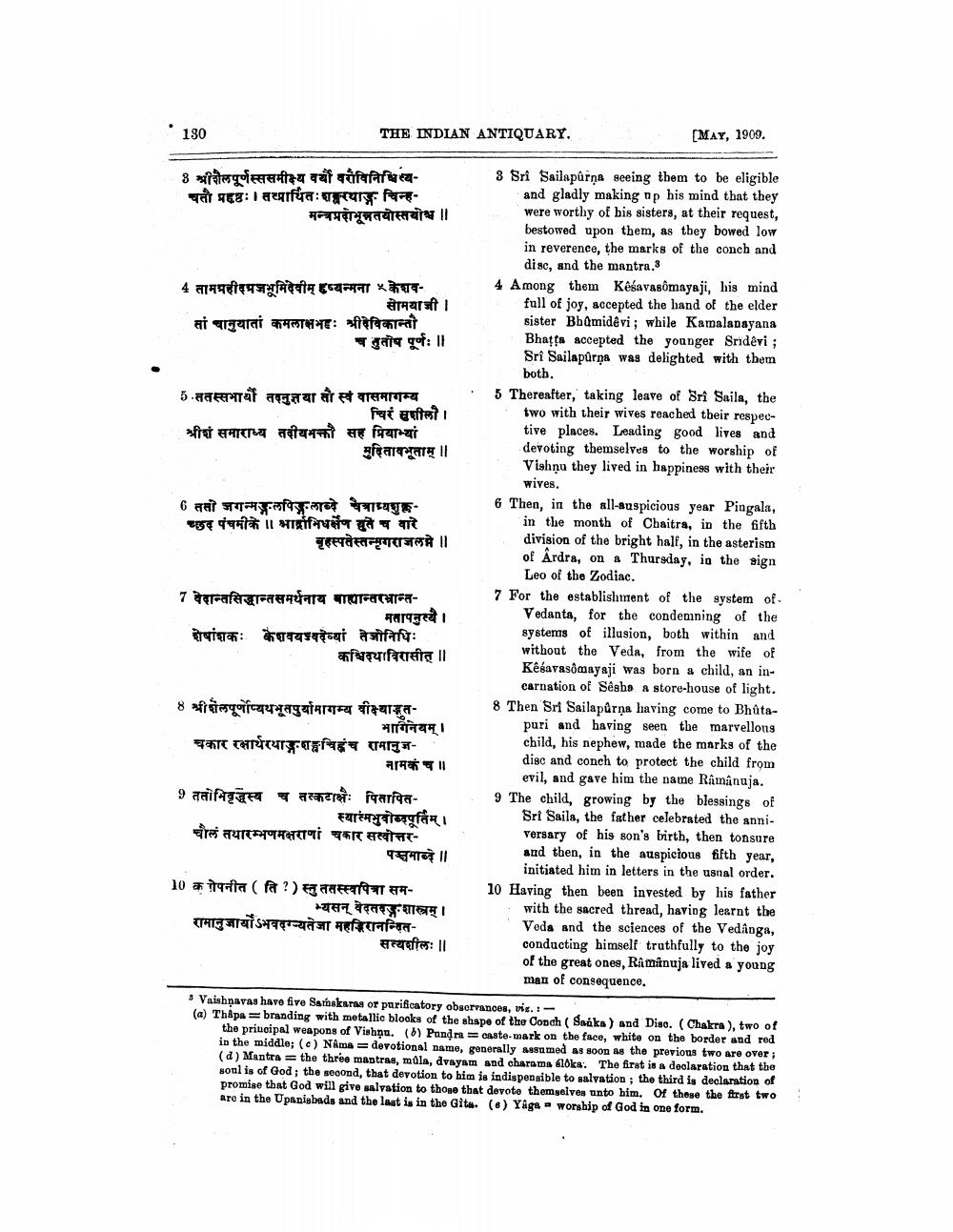________________
- 180
THE INDIAN ANTIQUARY.
PMAY, 1900.
श्रीशैलपूर्णस्ससमीक्ष्य वौँ वरीविनिविस्यचतौ प्रहृष्ठः। तयार्थितः शहरथाजचिन्ह
मन्त्रप्रदोभूलतयोस्तयोश्च ।।
4 तामग्रहीदप्रजभूमिदेवीम् हव्यन्मना केशव
सोमयाजी। सां चानुयातां कमलामभहः श्रीदेविकान्तौ
चतुतोष पूर्णः॥
5.ततस्सभायौँ तनुज्ञया तौ स्वं वासमागम्य .
चिरं सुशीलो। श्रीशं समाराध्य तदीयभक्ती सह प्रियाभ्यां
मुदितावभूताम् ।।
तसो जगन्मङ्गलपिङ्गलाब्वे चैत्राभ्यशुक्लच्छद पंचमीके ॥ भाभिधःण खुते च वारे
बृहस्पतेस्तन्मृगराजलमे ॥
8 Sri Sailapurņa seeing them to be eligible
and gladly making up his mind that they were worthy of his sisters, at their request, bestowed upon them, as they bowed low in reverence, the marks of the conch and
disc, and the mantra 3 4 Among them Kesavasomayaji, his mind
full of joy, accepted the hand of the elder sister BhQmidêvi ; while Kamaladsyana Bhatts accepted the younger Sridevi ; Sri Sailapurna was delighted with them
both. 5 Thereafter, taking leave of Sri Saila, the
two with their wives reached their respective places. Leading good lives and devoting themselves to the worship of Vishnu they lived in happiness with their
wives. 6 Then, in the all-auspicious year Pingala,
in the month of Chaitra, in the fifth division of the bright half, in the asterism of Ardra, on a Thursday, in the aign
Leo of the Zodiac. 7 For the establishment of the system of
Vedanta, for the condemning of the systems of illusion, both within and without the Veda, from the wife of Késavas mayaji was born a child, an in
carnation of Sêsho a store-house of light. 8 Then Sri Sailapůrna having come to Bhuta
puri and having seen the marvellons child, his nephew, made the marks of the disc and conch to protect the child from
evil, and gave him the name Ramanuja. 9 The child, growing by the blessings of
Sri Saila, the father celebrated the anniversary of his son's birth, then tonsure and then, in the auspicious fifth year,
initiated him in letters in the usnal order. 10 Having then been invested by his father
with the sacred thread, having learnt the Veds and the sciences of the Vedanga, conducting himself truthfully to the joy of the great ones, Ramanuja lived a young man of consequence.
7 वेदान्तसिद्धान्तसमर्थनाय बायान्तरभ्रान्त
मतापनुत्यै। शेषांशकः केशवयज्वदेव्यां तेजोनिधिः
कश्चिदथाविरासीत् ॥
8 श्रीशैलपूर्णोप्ययभूतपुर्यामागम्य वीक्ष्यामृत
__भागिनेयम् । चकार रक्षार्थरथाङ्गशङ्कचिह्नंच रामानुज
नामकं च ॥ 9 ततोभिवृद्धस्य च तत्कटाक्षः पितापित
___ स्यास्मभुवोतपूर्तिम्। चौलं तथारम्भणमक्षराणां चकार सवोत्तर
पचमान्ने ॥
10 करोपनीत (ति?)स्तु ततस्स्वपित्रा सम
भ्यसन् वेदतरङ्गशास्त्रम् । रामानुजार्योऽभवदग्यतेजा महडिरानन्दित
सत्यशीलः॥
• Vaishṇavas have five Samskarns or purificatory observances, vis. (a) Th&pa=branding with metallic blooks of the shape of the Conch ( Saaka) and Diso. (Chakra), two of
the principal weapons of Vishnu. () Pandra = caste-mark on the face, white on the border and red in the middle; (c) Nama devotional name, generally assumed as soon as the previous two are over; (d) Mantra = the three mantras, mola, dvayam and charama flokes. The first is a declaration that the soul is of God; the second, that devotion to him is indispensible to salvation; the third is declaration of promise that God will give salvation to those that devote themselves into him. Of these the first two are in the Upanishads and the last is in the Gita (@) Yags worship of God in one form.




